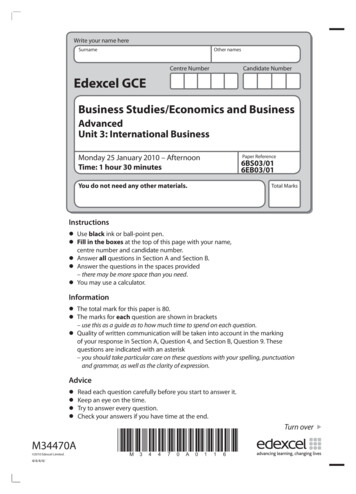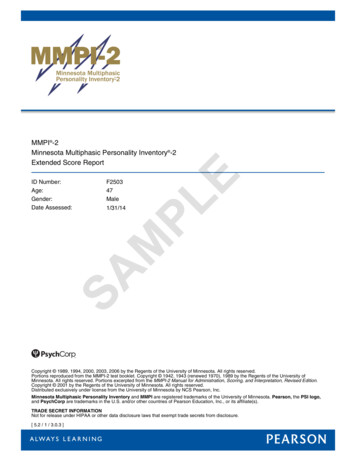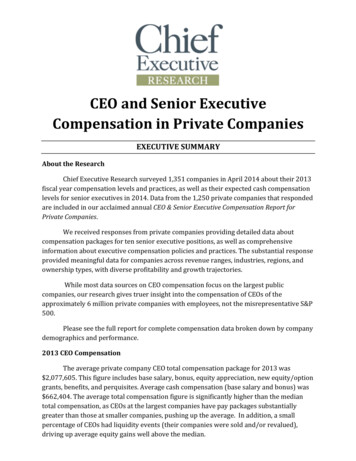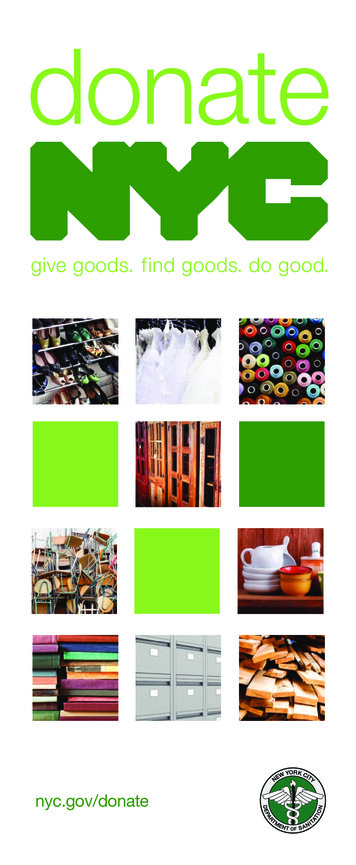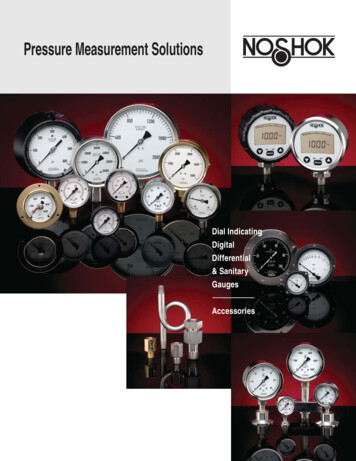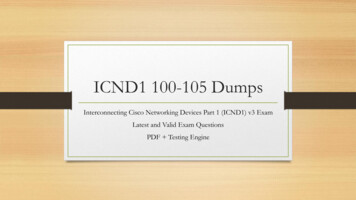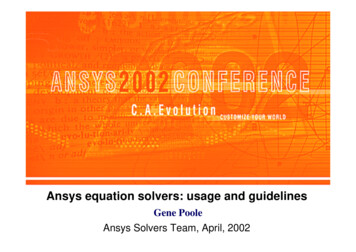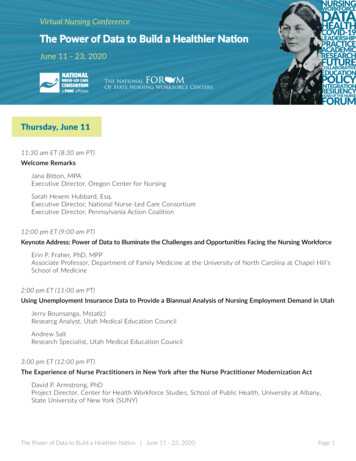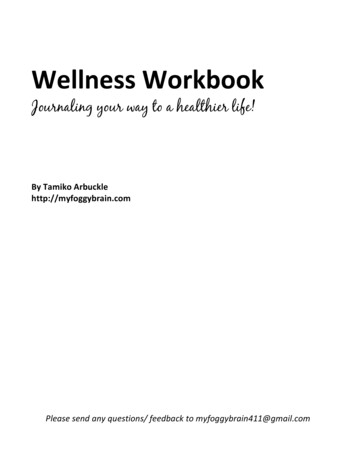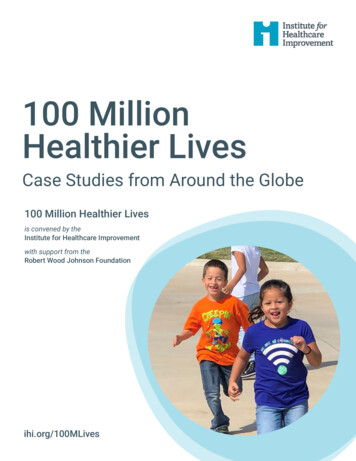
Transcription
Convened by100 MillionHealthier LivesCase Studies from Around the Globe100 Million Healthier Livesis convened by theInstitute for Healthcare Improvementwith support from theRobert Wood Johnson Foundationihi.org/100MLives
100 Million Healthier Lives: Case Studies from Around the GlobeAuthorsMartha Hostetter, MFA, Partner, Pear Tree CommunicationsSarah Klein, AB, Partner, Pear Tree CommunicationsAcknowledgmentsIHI is grateful to IHI team members Sarah Callender, Marianne McPherson, Paul Howard,Shannon Welch, and Joelle Baehrend for their support of 100 Million Healthier Lives and theireditorial guidance in creating this content.How to Cite This Document: Hostetter M, Klein S. 100 Million Healthier Lives: Case Studies from Around theGlobe. Boston: Institute for Healthcare Improvement; 2020. (Available at www.ihi.org/100MLives)Cover photo: The Daily Mile USA100 Million Healthier Lives100 Million Healthier Lives is a global movement (2014 to 2020), convened by the Institute for Healthcare Improvement and fundedin part by the Robert Wood Johnson Foundation, with an audacious goal: 100 million people living healthier lives worldwide by theend of 2020 by fundamentally transforming the way the world thinks and acts to improve health, well-being, and equity.Institute for Healthcare ImprovementFor more than 25 years, the Institute for Healthcare Improvement (IHI) has used improvement science to advance and sustainbetter outcomes in health and health systems across the world. We bring awareness of safety and quality to millions, acceleratelearning and the systematic improvement of care, develop solutions to previously intractable challenges, and mobilize healthsystems, communities, regions, and nations to reduce harm and deaths. We work in collaboration with the growing IHI communityto spark bold, inventive ways to improve the health of individuals and populations. We generate optimism, harvest fresh ideas,and support anyone, anywhere who wants to profoundly change health and health care for the better. Learn more at ihi.org.Copyright 2020 Institute for Healthcare Improvement. All rights reserved. Individuals may photocopy these materials foreducational, not-for-profit uses, provided that the contents are not altered in any way and that proper attribution is given to IHI asthe source of the content. These materials may not be reproduced for commercial, for-profit use in any form or by any means, orrepublished under any circumstances, without the written permission of the Institute for Healthcare Improvement.Institute for Healthcare Improvement ihi.org/100MLives 2
ContentsIntroduction.4Leading for Outcomes.8Leading for Equity.11Leading Together.13Leading from Within.16Leading for Sustainability.18Moving Forward.19Tools and Resources.21References.23
100 Million Healthier Lives: Case Studies from Around the GlobeIntroductionDespite trillions of dollars invested in medical and publichealth services, millions of people in the US and around theworld struggle to live healthy lives. While some have accessto best-in-class treatments, many can’t afford care and lackthe safe housing, healthy food, or good jobs we all need tothrive. These inequities were forged in past discriminatorypolicies, such as redlining in the US, as well as policies andpractices we still live with today, such as structural racismand disinvestment in low-income communities. They leadto differences in lifespan by gender, geography, and race aswell as inequities in infant and maternal health outcomes,child development, and prevalence of chronic diseases,among many others.In the US, the Patient Protection and Affordable Care Actof 2010 took aim at these inequities by making health caremore accessible and affordable for more people. Whilemany clinicians and health system leaders welcomedthis change, they recognized that no matter how hardthey worked, they couldn’t improve population health withmedical services alone — or without a deliberate focuson those who are not thriving. “We knew we would neverachieve the health outcomes we seek without addressingequity and people’s social needs,” says Somava Saha, MD,MS, the founding Executive Lead of 100 Million HealthierLives and founder of Well-being and Equity (WE) in theWorld, an organization that seeks to promote both. “Wecould see that this would require multisector solutions andthat we didn’t have them.”In 2014, Saha and others at the Boston-based nonprofitInstitute for Healthcare Improvement (IHI) convened peoplefrom some 200 organizations, representing the publichealth, health care, policy, research, and business sectorsas well as patients, who shared a frustration with the lackof progress and a desire to try a fundamentally differentapproach. Participants committed to going beyond thewas ambitious enough to compel collaboration and newapproaches. “To achieve this goal, we knew we’d haveto think bigger and broader and more strategically,” saysNiñon Lewis, Head of Content Portfolios for IHI. Thecoalition also agreed that health systems themselvesshould not lead, but rather support community membersand organizations actually doing the work. “We recognizedthat what we needed was a fundamentally new way ofworking together in the world to create health, well-being,and equity,” says Marianne McPherson, Senior Director atIHI. “And we knew that we, ourselves, would need to beopen to change from the inside out.”What Helps Movements SucceedTo find the most effective ways of working together, IHI andits partners studied what had made previous campaignssuccessful. They considered their own efforts to promotesafer hospital care through IHI’s 100,000 Lives Campaign,which reduced adverse drug events, infections, and othercommon patient safety issues, and Project Fives Alive!,which dramatically increased the number of newborns inGhanaian families who receive timely postnatal care, inaddition to others’ campaigns, including the Safety NetMedical Home Initiative, which helped 65 primary carepractices serving low-income Americans expand accessto services while improving care quality and patients’experiences.Some common threads emerged, among them: successfulefforts weren’t framed as “initiatives,” with set budgets andtimelines, but rather as movements that gather momentumfrom shared principles and behaviors that can be sustainedover the long term. They also inspired people to thinkand act in different ways, and encouraged distributedleadership and decision making across their networks soall members felt empowered to speak up. Many also drewin young people, both as a way of harnessing their energyand of building a pipeline of leaders to carry on the work.four walls of their institutions to tackle problems such aschronic illness, education, homelessness, and foodinsecurity, which they knew they couldn’t solve on theirown. Eventually, they set an audacious target — improvingthe lives of 100 million people worldwide by 2020 — thatInstitute for Healthcare Improvement ihi.org/100MLives 4
100 Million Healthier Lives: Case Studies from Around the GlobeParticipants also agreed that it would not be possible tomeaningfully improve population health without turningaspirations for equity into action. “We saw that equity waspart of the mission statement of many organizations,”says Saha, “but that didn’t actually change how theywere working.” Achieving meaningful change requiredparticipants to deliberately focus on factors such assystemic racism, prejudice, and power structures thatfueled inequities; identify those who were and weren’tthriving in their communities; and actively engage peoplewith direct experience of inequities in co-designingsolutions.”Members of the initial leadership group worked togetherto establish guiding principles and enlist new partners.Starting in 2015, with funding from the Robert WoodJohnson Foundation, they invited 24 community coalitionsfrom across the US to join them in developing and testingthe skills, methods, and tools needed to make rapidprogress. Each had embraced a broad definition of whatconstitutes health and well-being — employing a diversearray of strategies from advocating for higher minimumwages to reducing youth homelessness and childhoodobesity to promoting food security. The program, SpreadingCommunity Accelerators through Learning and Evaluation(SCALE), was jointly managed by IHI, Communities Joinedin Action, Community Solutions, and the Network forRegional Health Care Improvement, each of which broughttheir own expertise.“ A lot of the CHILA experience involved openingour hearts and bringing our whole selves to thetable rather than our credentials and accolades.As a self-proclaimed person who is ratherimpatient and was not interested in those thingsin the beginning, I have seen it work time andtime again — that if we create space and weprioritize those things, it accelerates change.”— Tricia Zahn, Director of Community Strategic Partnerships,Center for Population Health, Cheshire Medical Center, Keene,New Hampshire (SCALE Community Partner)Learning How to SCALESCALE was designed to strengthen the capacity ofcommunity groups to achieve a culture of health byoffering their leaders new tools, skills, and methodsfor accelerating transformation, as well as ampleopportunity to learn from one another as they testedout new approaches to measurement, leadership,and collaboration.1 Below is a list of the 24 SCALEcommunities. Atlanta Regional Collaborative for HealthImprovement: Atlanta, Georgia Bernalillo County Community Health Council:Albuquerque, New Mexico Brooklyn Park: Minneapolis, Minnesota BuckeyeHEAL: Cleveland, Ohio Ethnic Community-based Organization forRefugees: Salt Lake City, Utah Healthy Livable Communities Consortium ofCattaraugus County: Salamanca, New York Healthy in the Hills: Williamson, West Virginia Healthy Monadnock: Keene, New Hampshire Healthy Waterville: Waterville, Maine Health Improvement Partnership of MaricopaCounty: Phoenix, Arizona Jackson Collaborative Council: Jackson, Michigan Laramie County Community Partnership:Cheyenne, Wyoming Live Algoma: Algoma, Wisconsin North Colorado Health Alliance: Evans, Colorado Proviso Partners for Health: Chicago, Illinois Pueblo Triple Aim Corporation: Pueblo, Colorado San Gabriel Valley Healthy Cities Collaborative:Los Angeles, California Southeast Raleigh YMCA: Raleigh, North Carolina SitkaHealth Summit Coalition: Sitka, Alaska Summit County: Akron, Ohio Tenderloin Health Improvement Partnership:San Francisco, California Vital Village Network: Boston, Massachusetts Wellness Now: Oklahoma City, Oklahoma Women of Skid Row: Los Angeles, CaliforniaInstitute for Healthcare Improvement ihi.org/100MLives 5
100 Million Healthier Lives: Case Studies from Around the GlobeSCALE participants formed coalitions within theircommunities, partnered with improvement advisors, andidentified community champions who had lived experiencewith the problems the communities were tackling.They also participated in several Community HealthImprovement and Leadership Academies (CHILAs), whichoffered a deep dive into improvement methodologiesand leadership skills. Between three and four days inlength (or over an extended period of time if conductedvirtually), CHILAs enabled communities and organizationsto experiment with new skills and forge supportiverelationships that facilitate peer-to-peer learning in themonths and years after.Spreading Community Acceleratorsthrough Learning and EvaluationSCALE was jointly managed by four partnerorganizations, each of which brought theirown expertise. IHI offered its expertise in quality improvement,collaborative learning, and facilitation andconvening. Community Solutions helped participantssee the benefits of applying improvementscience to create practical solutions in thesocial sector and contributed knowledge aboutdesign thinking and building and sustainingmovements. Communities Joined in Action shared itsexperience with convening community membersand community coalitions to increase access tohealth care and reduce health disparities. The Network for Regional Health CareImprovement introduced new ways of learningand working together online, based on theorganization’s experience running the AligningForces for Change campaign, a communitybased quality improvement initiative funded bythe Robert Wood Johnson Foundation.During Action Periods, participants received coachingas they applied new approaches to goal setting, qualityimprovement, and leadership. Limited to three to fourmonths, these periods allowed participants to learn what wasor was not working and to make improvements in real time.Equity Action Labs leveraged community-wide collaborationand quality improvement techniques to advance equity,using a structured process that included engaging thosewith lived experience of inequities, co-designing and testingsolutions, and building upon them over a defined period oftime, often 100 days.2SCALE communities also served as peer coaches forone another, enabling them to learn from each other’ssuccesses and see firsthand the benefits of creating anenvironment in which teams felt safe enough to try newideas and learn from mistakes. This approach, known as“failing forward,” allows teams to learn faster and reachhigher levels of performance than they might otherwiseachieve.Community of Solutions FrameworkOver two years, a framework emerged from SCALE. Knownas the Community of Solutions, it takes its name from the1967 Folsom Report, which advocated for bridging thedivide between public health and medicine and engagingcommunities in addressing the social and environmentaldrivers of poor health. The new framework offers skills100 Million Healthier Lives is made up of change agents from acrossthe globe.Institute for Healthcare Improvement ihi.org/100MLives 6
100 Million Healthier Lives: Case Studies from Around the GlobeCommunity of Solutions FrameworkThe Community of Solutions framework offers a wide array of skills, tools, and behaviorsthat can be applied to accelerate community transformation.Leading for Outcomes: Support communities in applying design skills to co-create a theoryof change, identify measures, test the theory, and plan for implementation and scaling in away that makes these tasks easier.Leading for Equity: Engage those with lived experience of inequity in developing andtesting policy and programmatic changes that have the potential to disrupt systemsperpetuating racism and inequity.Leading Together: Create a safe space for collaboration that allows for difficultconversations and promotes effective teamwork.Leading from Within: Lean on joy, inspiration, and self-reflection to unlock leadershippotential in oneself and others.Leading for Sustainability: Put structures in place to promote ongoing transformationand scale successful models.Institute for Healthcare Improvement ihi.org/100MLives 7
100 Million Healthier Lives: Case Studies from Around the Globefor tackling what many see as intractable problems. Itreframes challenges by attempting to shift mindsets,putting the emphasis on identifying and leveraging theresources that exist in communities, rather than focusingon deficits. The Community of Solutions framework alsoencourages organizations to achieve progress by beginningsmall and applying new skills and behaviors to solvinglarger and larger challenges, using the tools of qualityimprovement such as driver diagrams and Plan-Do-StudyAct cycles.3 Taken together, they help people find new waysof working that encourage peer-to-peer learning, engendertrust through relationship building, and foster creativity inproblem solving, partly by recognizing the untapped talentsof those who have been marginalized.The case studies presented in this document highlight how10 organizations have used the Community of Solutionsframework to shift their organizational cultures, drill downto identify the root causes of inequity, find new allies, andmake progress. These cases are just a sampling of thehundreds of organizations around the world that are usingthe Community of Solutions framework to change theway they look at problems, partner with others to developand test solutions, and build systems for measuring theireffectiveness and spreading success. For clarity, we’vefocused on how these organizations have leveragedparticular skills and behaviors. But components of theCommunity of Solutions framework are not used inisolation; they reinforce one another, creating a positivecycle that sparks and sustains improvement. “The realstrength of the framework is that once embedded in acommunity, these skills are mutually reinforcing — providingthe necessary foundation for community transformation,”says Paul Howard, MPA, Senior Director at IHI.At the end of this document is a list of tools and resourcesdeveloped in partnership with 100MLives communities.Organized into five categories — CommunityTransformation, Advancing Equity, Measuring Impact,Engaging People with Lived Experience, and PopulationHealth Resources for Health Care Organizations — theseresources help support organizations, communities, andnetworks to advance health, well-being, and equity.Leading for OutcomesSupport communities in applying design skills to co-createa theory of change, identify measures, test the theory, andplan for implementation and scaling in a way that makesthese tasks easier.Community SolutionsAs one of the leaders of the 100 Million Healthier Livesmovement, the US-based nonprofit organization CommunitySolutions was instrumental in helping others see just howmuch of a difference the right measurement approach canmake. It was hard-won knowledge that emerged from itsyears of effort to end long-term or repeated homelessness,which is often referred to as chronic homelessness.Like other organizations, Community Solutions hadset an ambitious target — finding 100,000 new homesfor people experiencing chronic homelessness — andworked very hard to achieve it only to discover they werewinning the battle but losing the war. After four years ofits 100,000 Homes Campaign (2010 to 2014), housingadvocates across the US had created 106,000 new housingplacements, but the number of people experiencinghomelessness hadn’t budged; in some cities, that numberactually increased.Leaders at Community Solutions realized they neededa different approach that targeted root causes, andthat would require having a deeper understanding ofthe particular reasons why people experience chronichomelessness. They set a new target: rather than add upthe number of housing placements, they would count downuntil no one experienced chronic homelessness, whichthey refer to as “functional zero.” The name of the Built forZero campaign, launched in 2015, reflects this shift.Institute for Healthcare Improvement ihi.org/100MLives 8
100 Million Healthier Lives: Case Studies from Around the Globeled to substantial progress. Thus far, 13 communities haveachieved functional zero, making homelessness rare andbrief when it occurs; over half of the cities participatingin Built for Zero have substantially reduced the number ofindividuals experiencing chronic homelessness.This year, Community Solutions was named one of thefinalists in the MacArthur Foundation’s 100 million grant tofund a single proposal that promises real and measurableprogress in solving a critical problem of our time.Graphic: Community SolutionsHousing groups from across the US are working to end chronichomelessness in a campaign known as Built for Zero that relieson having real-time data on people living in the streets or shelters.The Health Improvement Partnershipof Maricopa CountyThe new target brought about a change in mindset thatushered in a new way of doing business. Participatinghousing groups from 80 different cities began to aggregatedata across all programs serving people experiencinghomelessness, enabling them to identify gaps — like areasof the city where no outreach teams reached — and modifytheir approaches accordingly. The result is that more than70 communities now have real-time, by-name data on everyperson experiencing chronic or veteran homelessnesson their streets and in their shelters. This had never beendone before, according to Jake Maguire, Built for Zero’sCo-Director. “It was an open question,” he says. “Couldyou track this incredibly dynamic, mobile, anonymouspopulation comprising people who often don’t want toengage with you. and do it in real time?” It required newoutreach strategies and coordination among agencies, aswell as detailed maps to pinpoint where people were beingmissed. It took one city a full year to come up with a list.Community leaders striving to improve public health oftenturn to community health needs assessments and local,state, and national health indicators to identify disparitiesand chart a path forward. The Health ImprovementPartnership of Maricopa County, a cross-sector coalitionwith representatives from the public health agency, healthsystems, businesses, schools, and community-basedorganizations in the Phoenix area, took this approach. Itsfirst action plan, published in 2012, focused on reducingrates of obesity, diabetes, lung cancer, and cardiovasculardisease and recommended dozens of strategies to reducethem. “While we wanted any potential partner to see howthey could contribute to the work, as we got into it, werealized these topics were too broad and our partnershipwas too new to support focused workgroups. Anything youwere doing could fit into those buckets, making it difficultto align the work of coalition members,” says Becky Henry,Performance Improvement Coordinator at Maricopa CountyDepartment of Public Health.Having the by-name lists of people experiencinghomelessness enabled housing advocates to categorizegroups by type (e.g., families, veterans, youth) and identifyshared hurdles, revealing for example that some veteranswere staying in shelters because it was the only way theycould get dental care. They used firsthand stories such asthese to redesign their engagement approaches and getmore people into homes. Reframing the problem not asone of supply (i.e., not enough housing) but of focus (i.e.,on the reasons particular people remain on the street) hasAs a result of participating in the SCALE initiative, coalitionmembers narrowed their focus on the upstream conditionsthat contribute to poor health and looked for concrete waysto actively engage community members in developing andimplementing shared solutions instead of just reportingon what individual agencies were doing. After completinga new community health needs assessment with greaterfocus on consulting with community members andconsidering equity issues and their root causes, they setgoals focused on expanding access to health care, makingInstitute for Healthcare Improvement ihi.org/100MLives 9
100 Million Healthier Lives: Case Studies from Around the Globeit easier for people to find healthy foods, and ensuringchildren grow up in safe and supportive environments. Theyalso focused targets and measurements on areas wheredisparities were greatest and recruited people with livedexperience to serve on committees developing solutions.Following the principle described in Chip and Dan Heath’sbook Switch of “shrinking the change” to gain traction andlearn by doing, they set incremental goals and assessedprogress at frequent intervals.4 “Instead of trying to climbthe mountain, we tried to focus on just getting to the nextmilepost,” says Henry. “For example, in one of our coalitionmeetings, we explored the key concepts in the Switch bookand asked, ‘If our goal was to get grandma and grandpa togo to the doctor, how do we create clarity, increase desire,and create an environment that makes it easier for anelderly couple to access basic primary care?’”The changes they sought also became more specific. Forexample, to increase access to healthy foods, coalitionmembers set a goal of making local produce available in 100stores, restaurants, schools, and daycares. Using the EquityAction Lab model, which offers a structured approach forengaging communities in designing solutions to inequities,they partnered with an urban farming group to distributeproduce that would otherwise go to waste to families inneed, setting an initial goal of reaching 50 families and fiveschools in 100 days.5 They then harvested lessons from that“sprint” to spread the program to the entire school district.“Now we’re looking at what it looks like to distribute foodthrough a community health center,” Henry says.Photo: Health Improvement Partnership of Maricopa CountyParticipants in Equity Action Labs convened by the Health ImprovementPartnership of Maricopa County set initial goals – including getting fivestreet lights fixed and distributing farm produce to 50 families in need –then figured out ways to achieve them and spread what worked.National Council on AgingBefore the National Council on Aging (NCOA), an advocacyorganization, joined 100 Million Healthier Lives, itsleaders had committed themselves to measuring theireffectiveness at improving the lives of older Americans. Totrack their progress in achieving their goal of making adifference in the lives of 40 million older Americans by2030, they counted: The number whose annual income increased orwhose annual expenses decreased by 1,200; The number enrolled in an evidence-based programshown to improve health and well-being; The number able to remain in the community insteadof being relocated to a nursing home; and The number who directly benefitted from a policychange linked to NCOA’s advocacy.In 2018, the NCOA took over the leadership of the AgingHub of 100 Million Healthier Lives, a collaborative thatincludes Area Agencies on Aging, Meals on Wheels, andother organizations that want to better understand andsupport older adults. In an effort to understand whatmatters to older adults, NCOA piloted the Well-BeingAssessment, a questionnaire created by the 100 MillionHealthier Lives Metrics Team that invites respondentsto rate their physical and mental health, as well as theirwell-being, including their finances and sense of purpose.6“Meaning and purpose, physical and mental health, andsocial connections are key ingredients for aging well,” saysDorothea Vafiadis, Director of NCOA’s Center for HealthyAging. “The Adult Well-Being Assessment is one way tomeasure these and other factors. We can then apply thefindings to scale services and programs that address thoseneeds.” Feedback from older adults led NCOA to tailor thesurvey by adding a question about loneliness, which is acommon experience among older adults and one that candegrade health. They also shortened the time period forwhich respondents are asked to envision their future fromfive to two years, since older adults said they had troublethinking too far down the road.Institute for Healthcare Improvement ihi.org/100MLives 10
100 Million Healthier Lives: Case Studies from Around the GlobeLeading for EquityEngage those with lived experience of inequityin developing and testing policy and programmaticchanges that have the potential to disrupt systemsperpetuating racism and inequity.Proviso Partners for HealthPhoto: Michael Paras, courtesy of National Council on AgingThe National Council on Aging piloted the Well-Being Assessmentamong older adults, then adapted it based on their feedback.NCOA then created a toolkit to help its partners in the100MLives Aging Hub, as well senior centers and othercommunity providers, use the Well-Being AssessmentTailored for Older Adults to measure whether their servicesare meeting seniors’ needs and take steps to addressshortfalls. The Baltimore County Department on Aging(BCDA) has fielded thousands of assessments and madechanges at its 20 senior centers based on results: addingmore opportunities to exercise and socialize in placeswhere low scores pointed to those gaps. And as thecoronavirus spread this spring, the BCDA used theassessment data to prioritize which seniors seemed mostvulnerable and should therefore receive the firstreassurance calls, reaching out to offer virtual programs,food deliveries, and referrals to other social services.The COVID-19 pandemic’s disproportionate impact onolder adults makes such efforts even more important,says Vafiadis. More organizations have begun using theassessment, including senior housing developers, volunteergroups, caregiving companies, and technology developers.Vafiadis hopes to partner with organizations servingSpanish-speaking seniors and other populations to continueto learn about the experiences of different groups. “We wantmore people to be able to measure what matters, becausethat way we can make comparisons and understand moreabout the needs of the people we’re serving,” she says.As of 2020, NCOA has reached 10 million older adultsand counting.When Lena Hatchett, PhD, the Co-Founder and ExecutiveLead of Proviso Partners for Health (PP4H), met LorettaBrown, a longtime resident of Maywood, Illinois, at acommunity meeting over a decade ago, she immediatelyrecognized a kindred spirit. Both women looked atMaywood, one of the poorest suburbs of Chicago, andthe surrounding towns that make up Proviso Townshipand saw diamonds in the rough. Yes, unemployment rateswere at an all-time high, half of its residents lived belowthe poverty level, and only two of five students graduatedfrom high school, but Hatchett and Brown shared a visionfor what Maywood could be if residents came to see theirown potential and work together to build a place where allresidents could thrive.The two women started small with a farmer’s market. Itdidn’t take off, but the public garden they cultivated acrossfrom a local high school did. Students tended plants thatbecame fo
Shannon Welch, and Joelle Baehrend for their support of 100 Million Healthier Lives and their editorial guidance in creating this content. How to Cite This Document: Hostetter M, Klein S. 100 Mil
